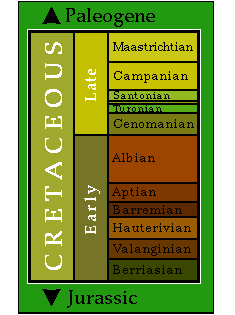The Cretaceous Period
144 to 65 Million Years Ago
The Cretaceous is usually noted for being the last portion of the "Age of
Dinosaurs", but that does not mean that new kinds of dinosaurs did not
appear then. It is during the Cretaceous that the first
ceratopsian and
pachycepalosaurid dinosaurs appeared. Also during this time, we find the
first fossils of many insect groups, modern mammal and bird groups, and
the first flowering plants.
The breakup of the world-continent Pangaea, which began to disperse during the
Jurassic, continued. This
led to increased regional differences in floras and faunas between the
northern and southern continents.
The end of the Cretaceous brought the end of many previously successful and
diverse groups of organisms, such as non-avian dinosaurs and ammonites.
This laid open the stage for those groups which had previously taken secondary
roles to come to the forefront. The Cretaceous was thus the time in which
life as it now exists on Earth came together.
Click on the buttons below to learn more about the Cretaceous.




 |
Subdivisions of the
Cretaceous:
The chart at left shows the major subdivisions of the Cretaceous Period.
The Coniacian Age is not labelled here, because it is too short to allow
this -- you will notice it as a narrow strip between the Santonian and Turonian.
This chart is mapped, to allow you to travel back to the Jurassic, or
forward into the Paleogene (in the Cenozoic Era).
The Cretaceous Period is part of the
Mesozoic Era.
|
Oceans of Kansas has information on marine organisms from the central United States.
Find out more about the Cretaceous paleontology and geology of North America at the Paleontology Portal.










